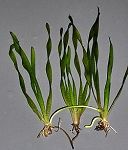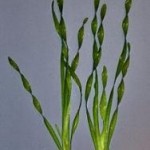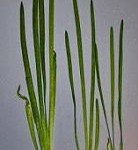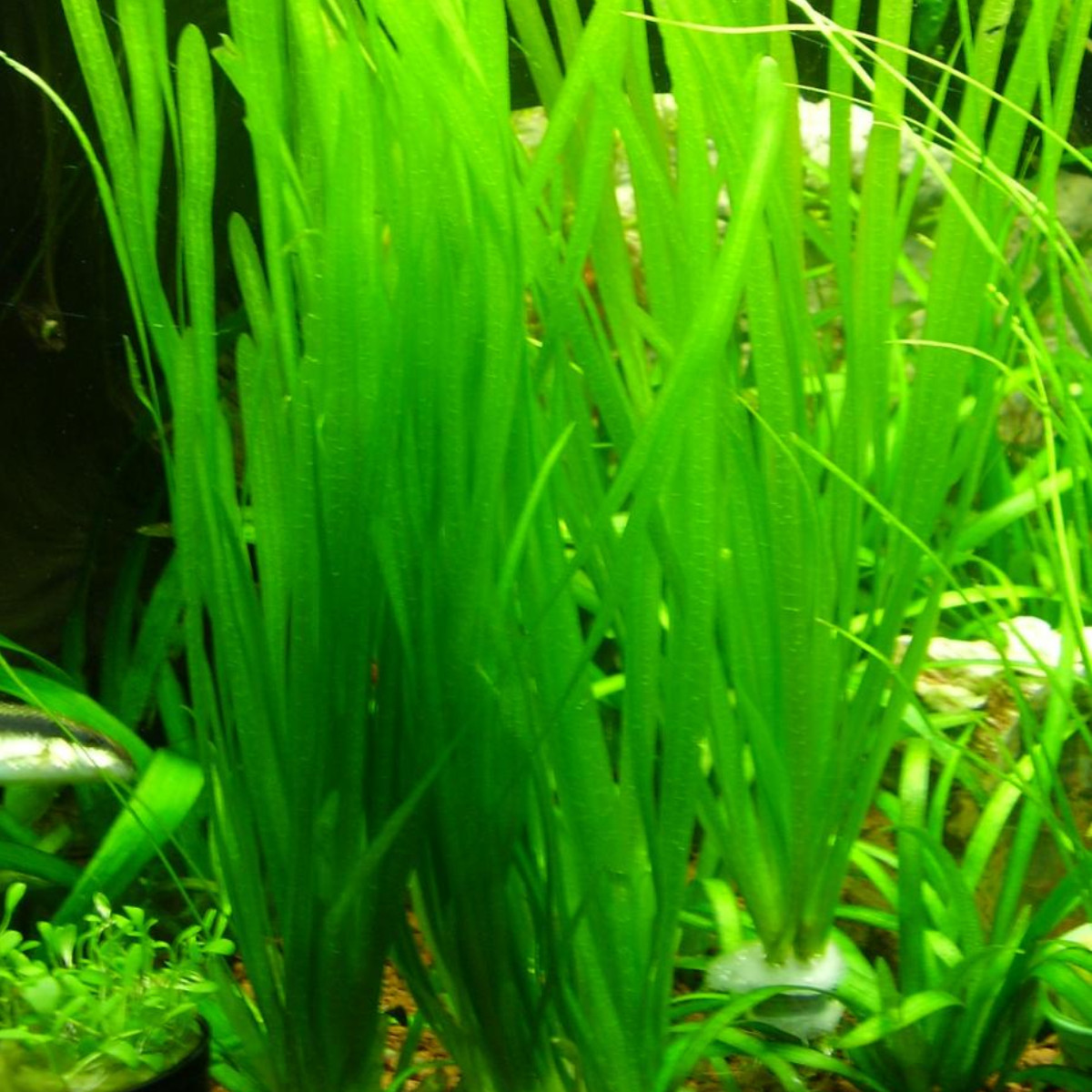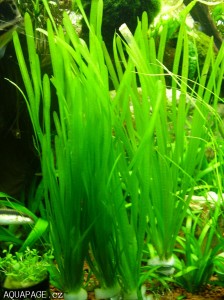Family: Hydrocharitaceae
Synonym: Vallisneria americana
Distribution and habitat: Vallisneria gigantea occurs naturally in Iraq, China, Japan, Korea, India, Papua New Guinea, the Philippines, Australia, Canada, the United States, Mexico, Guatemala, Honduras, Cuba, the Dominican Republic, Haiti and Venezuela.Vallisneria gigantea blooms all year and occurs almost always (estimated probability 99%) under natural conditions in wetlands. Long, flattened, ribbon-like leaves arising from a cluster at the base of the plant are minutely serrate with bluntly rounded tips. Leaves grow to 1.5m (5 feet) in length and approximately 1cm (0.4 inch) width. A light green stripe runs down the center of the finely-veined leaves.
Vallisneria gigantea grows in ponds, lakes and quiet streams at depths of 1 to 4m (3-13 feet). Vallisneria gigantea likes quiet waters such as lakes and slow flowing streams, fresh to brackish waters of streams, lakes, rivers and bays from sea level to 500m (1,640 feet). It is a native submerged plant that forms long ribbon like leaves growing up from the bottom of a pond or dam.
Description: Vallisneria gigantea is a genus of freshwater with long leaved grass-like aquatic plant. This plant will get rather large and will form a dense cover at the water surface which will aid in the control of free floating algae (green water).
In most aquariums the leaves grow so long that they float on the surface. Vallisneria gigantea leaves arise in clusters from their roots. Leaves grow up to 120cm (47 inch) long and 12mm (0.4 inch) wide. So the plant needs pruning to stop it taking too much light from plants growing beneath. The leaves are tough and strong, so they are not normally eaten by herbivorous fish, dark green coloured with rounded tips and definite raised veins. They generally grow in cycles, thriving for 3 or 4 months and then dying off for another few months.
Vallisneria gigantea is dioecious and individual plants are either male or female. Individual pistillate flowers have three sepals and three white petals, and occur in a tubular spathe that grows to the water surface at the end of a long peduncle. Staminate (male) flowers are crowded into an ovoid spathe borne on a short peduncle near the base of the plant. Eventually the spathe of staminate flowers breaks free and floats to the surface where it releases its flowers. Fertilization occurs when male flowers float into contact with female flowers. When fertilization is complete the peduncle of the pistillate flower coils up and fruit develops underwater. Fertilization produces a long cylindrical pod containing small, dark seeds.
Care:Vallisneria gigantea is very fast growing, it has been recorded to grow 1cm (0.4 inch) a day. Always make sure that the leaves do not get fractured, as soon as this happens the leaf will die off.This plant can be pruned as long as the leaves are cut back with sharp scissors. Leaves that are dying off can also be removed by lifting them away at the base. Usually requires about 2-4 weeks for acclimatization but later it can reproduce and can become the primary plant in the fish tank.
Water: Water hardness and pH level are not vital factors for Vallisneria gigantea, but prefer alkaline water. Vallisneria gigantea does not like flowing water so plant away from filter return pipe.
Vallisneria giganteamust be planted under water 2.5 to 15cm (1-6 inch) deep.
Temperature:Vallisneria gigantea has a large range of water temperature from 20 to 28C (68-82F).
Light:Vallisneria gigantea takes full sun to light shade; growth will be faster and stronger under brighter light.
Substrate: Vallisneria gigantea do well in a mixture of fine sand with a medium light level. Iron is important for these plants, and the best way to ensure that they get the right quantities is to use an iron-rich substrate. Recommended substrate for growing is gravel.
When planting Vallisneria gigantea always leave the crown of the plant above the substrate, this is easy to spot as the crown will have a lighter colouration as the rest of the plant.
Fertilise: In order to stimulate the growth, an iron-rich fertiliser should be added to the water periodically.
Propagation: Propagation of Vallisneria gigantea is really easy. After 2 to 4 weeks from planting the plant starts rooting and will produce runners. Do not separate the runner from the motherplant until it reached usable size. The transplanted new plant will stagnate and take one month (even more) before recovering and starting expanding and getting ready for another propagation.
Uses: Vallisneria gigantea are commonly grow in tropical and subtropical aquaria. Undemanding, fast growing plant, it is best suited to larger aquariums. Vallisneria gigantea makes as well good plant for the discus tank and in deep tanks such as cubes if sufficient light is provided. It can be used to hide filters and other equipment. It is a valuable for water oxygenation.
Vallisneria giganteais a good habitat plant for fish and birds when present in large plantings.
For pond proposes Vallisneria gigantea is suitable for: light (sandy), medium (loamy) and heavy (clay) soils. Suitable pH: acid, neutral and basic (alkaline) soils. It cannot grow in the shade. It can grow in water.
Recommended varieties:
Vallisneria americana var. biwaensis:This variety has narrow 3-5mm (0.1-0.2 inch) wide, strap-shaped, 5-50cm (2-19 inch) long leaves and produces beautifully twisted leaves with longitudinal nerves. This plant is particularly attractive as middleground plant or even foreground plant in large aquaria. This plant is a bit more light requiring than most other Vallisneria types but apart from than it is undemanding regarding water hardness and temperature.
Vallisneria americana "Mini Twister": It is used for the foreground in aquarium. As indicated by its name, Vallisneria americana "Mini Twister" is a rather small plant. The short leaves (10-15+ cm) (4-6 inch) make it particularly useful as foreground and middleground plant and the twisted leaves provides a colourful asset when light is reflected by the leaf surfaces.
Vallisneria americana var. natans: It is native to Australia and is a very hardy species suitable for an aquarium. The leaves are narrow (up to 10 mm (0.4 inch) wide) and strap-shaped, middle long (50-100 cm) (20-40 inch) and with 3-5 longitudinal nerves. Transverse nerves are randomly spread over the entire leaf. The plants natural occur in huge populations in standing as well as running waters. It is an easy and undemanding beginner's plant having no particular requirements for neither light nor CO2 and it grows in a wide temperature interval from 18-28C (64-82F). It is easily propagated via runners.
Interesting facts:Vallisneria gigantea is mostly found in permanent waters where it may form large continuous patches.The plant is not self-fertile. As most other obligate waterplants, it has evolved a specialized pollination strategy when reproducing sexually. The male flowers are released under water but since they are less dense than water they immediately float to the surface. Here, they are trapped by the female flower which are supported by a long flower stalk floating on the water surface. Hence, the pollination is not carried out by insects but by water movements carrying the pollen to the female flower. Characteristically, Vallisneria prefers hard water and is rarely found in soft and acid water in nature. The robust types are not demanding and do not need CO2 addition since they in nature occur on shallow water in lakes which are naturally poor in free CO2.
Asexual reproduction occurs when winter buds, or turions, form at the meristem ofVallisneria gigantea plants in late summer. These winter buds elongate in spring, sending a stolon to the surface from which a new plant emerges. During the growing season, each plant can send out rhizomes that grow adjacent to the parent plant. Sexual reproduction occurs in late July to September.
May be confused with: Bur-reeds (Sparganium spp.), submersed leaves of duck potato (Sagittaria spp.), northern mannagrass (Glyceria borealis), and wild rice (Zizania aquatica), which all can have long, ribbon-like underwater leaves, but do not have the distinctive midrib or the coiled fruit stalk of Vallisneria gigantea.
Vallisneria gigantea can be confused with Zostera marina. However,Vallisneria gigantea has a light green stripe in the center of its leaves and its leaves are generally broader than those of Zostera marina. BecauseVallisneria gigantea prefers lower salinity and Zostera marina higher salinity, the two species are not know to occur in the same location although their salinity ranges overlap slightly.
Hardy to zone: 9
